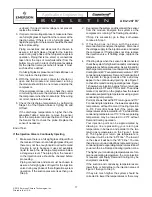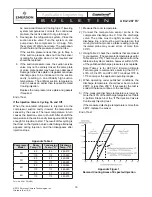
18
© 2012 Emerson Climate Technologies, Inc.
Printed in the U.S.A.
AE4-1287 R7
Application Engineering
B
U
L
L
E
T
I
N
Form No. 92-91 R2 (4/09)
be occasional Demand Cooling trips. If lowering
system temperatures corrects the continuous
problem, the test is ended, if not go to Step 5.
5. Deenergize the refrigeration system. Close the
suction service valve. Turn the system on and
pump down the compressor to 2-3 psig. Turn
the system off. Wait one minute. The pumpdown
should hold and the pressure should not rise.
If the suction pressure rises then go to Step 6.
If the suction pressure does not rise the sensor
is calling for injection when it is not required and
should be replaced.
6. If the suction pressure rises, the suction service
valve may not be entirely closed, the valve plate
or valve plate gasket may have been damaged.
Damage to the valve plate or its gasket can cause
discharge gas to be introduced to the suction
cavity, resulting in an artificially high suction
temperature. The arti
fi
cial suction temperature,
in turn, causes an earlier than required Demand
Cooling injection.
Replace the compressor valve plate and gaskets
if required.
End of Test
If the Injection Valve is Cycling On and Off
When the saturated refrigerant is injected into the
compressor suction cavity it lowers the temperature
sensed by the sensor. The lower temperature in turn
causes the injection valve to shutoff. After shutoff the
temperature in the suction cavity rises again until it is high
enough for injection to start. The result of this cycling is
that frost on the injection valve outlet tubing alternately
appears during injection, and then disappears after
injection stops.
1) Measure the room temperature.
2) Connect the temperature sensor probe to the
compressor discharge line 6” from the discharge
valve. The probe must be tightly secured to the
discharge line, and must be well insulated so that
moving air will not produce a false reading (a poorly
insulated probe may cause errors of more than
30°F!).
3) Using Table 2, check the conditions that are closest
to your system. (The evaporator temperature used for
Table 2 was -25°F). There may be deviation from the
table due to system variation, however, within 5-10%
of the published discharge pressures is acceptable.
Note! Table 2 is for HCFC-22. Emerson Climate
Technologies recommends assuming that
HFC-
407A, HFC-407C and HFC-407F
run about 10°F to
15°F cooler per the approved operating ranges.
4) When operating under published conditions, the
discharge temperature should never be more than
280°F or less than 200°F. If successful, the test is
ended. Otherwise continue to the next step.
5) If the measured discharge temperature is lower by
more than 10% of the discharge temperature of Table
2, perform Steps 5-8 of the “If The Injection Valve Is
Continually Injecting” test.
If the measured discharge temperature is more than
280°F, replace the sensor.
End of Test
Appendix Figure 1
Demand Cooling Areas of Expected Injection
Compressor
Model
Room
Temp. (°F)
Condensing
Temp. (°F)
Discharge
Temp. (°F)
2D
80
80
250-270
110
110
270-280
3D
80
80
240-256
110
110
265-280
4D
80
80
230-260
110
110
260-280
6D
80
80
250-270
110
110
250-270
Appendix Table 2

































